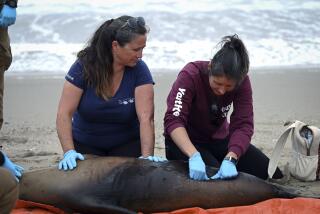Pelicans’ health problems may be tied to Pacific Northwest storm of December
Scientists said Friday they believe a severe storm off the coasts of Oregon and Washington in December may be responsible for the bruised and confused California brown pelicans reported in recent weeks throughout California, far from their seaside homes.
About 4,000 of the big brown birds had enjoyed an unusually warm November in Oregon when they were suddenly hit by freezing temperatures and 60 mph winds, said David A. Jessup, senior veterinarian for the California Department of Fish and Game.
Many of the pelicans were starving and suffering from frostbite and diseases including pneumonia, bronchitis and hepatitis when they were forced to make a 1,000-mile trip to warmer climates in Southern California.
“A high proportion of these birds are adult,” Jessup said, “and quite a few have severe frostbite injuries: frozen toes and foot webs, and nasty lesions on their pouches.
“They’re in pretty good body condition otherwise. Even confused and depressed pelicans were not showing signs of brain damage.”
But exposure to bad weather doesn’t explain all of the problems discovered in blood and tissue samples of pelicans found dead or dying on airport runways, farm fields, freeways and high in the mountains.
For example, blood samples from four of 19 ailing birds sent to USC biology professor David Caron for analysis had detectable levels of potentially fatal algae toxins such as domoic acid.
Additional tests were being conducted by the Department of Fish and Game, the National Wildlife Health Center in Madison, Wis., the California Animal Health and Food Safety Laboratory at UC Davis and SeaWorld in San Diego.
Jessup said he planned to release a report on the problem within a few days.
In the meantime, wildlife rescuers from San Francisco to San Diego continued to retrieve and rehabilitate hundreds of stricken pelicans.
“Until complete test results are available, we’re not prepared to say what is to blame for the constellation of symptoms we’ve been seeing in these birds,” said Laurie Pyne, development director for the International Bird Rescue Research Center. “We’re still trying to put the puzzle pieces together.”
More than 70,000 breeding pairs of pelicans inhabit California and Baja California, Mexico, and total numbers have surged to about 620,000 birds along the West Coast, Gulf Coast and Latin and South America.
--
More to Read
Sign up for Essential California
The most important California stories and recommendations in your inbox every morning.
You may occasionally receive promotional content from the Los Angeles Times.











